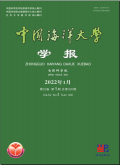中国海洋大学学报(自然科学版)2024,Vol.54Issue(1):12-25,14.DOI:10.16441/j.cnki.hdxb.20220275
1961-2020年华北地区7-8月份极端降水频次趋势转折及可能原因分析
Analysis of the Trend Turning and Possible Causes of Extreme Precipitation Frequency in July—August in North China from 1961 to 2020
摘要
Abstract
Regional extreme precipitation(REP)is highly destructive and can cause geological disasters and economic losses.Using daily precipitation data,this paper investigates the REP frequency trend turning in July-August in North China from 1961 to 2020,and explores the possible causes of the varia-tion.The results show that there are three trend abrupt points in July-August REP days in North Chi-na,1986,1995 and 2003,with decreasing trends in the 1961-1985(P1)and 1995-2002(P3)periods,and increasing trends in the 1986-1994(P2)and 2003-2020(P4)periods.The anomalous divergence of moisture flux is present in North China,and anomalous high(Northeast high)is present in the upper troposphere from northeastern China to the Korean Peninsula at the REP event.The enhanced anoma-lous divergence of moisture flux in north China south of 38°N during the P2 and P4 periods compared with the P1 and P3 periods corresponds to the southward position of Northeast high,resulting in more REP days at the region.The anomalous moisture flux comes from the Indian Ocean and the northwest Pacific Ocean during P1 and P2,but only from the northwest Pacific Ocean in the latter two periods,which is the result of the weakening of the East Asian summer monsoon(EASM)and the strengthening of the western Pacific subtropical high(WPSH).The development of Northeast high during P1 and P3 is associated with the wave activity flux transmitted along the mid-latitude westerly jet stream(WJS).While the high-latitude activity center plays a role during P2 and P4 and the Northeast high is stronger in the seasonal background.The wave activity flux contributing to the development of Northeast high during P2 comes from both the WJS and the high-latitude activity center paths,while the wave activity flux during P4 propagates mainly along the high-latitude.The decrease of REP days in the P1 period is mainly the result of the significant weakening of the EASM,which is not conducive to water vapor transport to North China,while the P3 period is the result of the combined effect of the reduced EASM and the weakening of the WJS.The increase of REP days in the P2 period is due to the significant strengthening of the WJS,which is favorable to the development of Northeast high,while the P4 period,the strengthening of the WPSH ensures the water vapor transport to North China after the weakening of the EASM,and the reduction in the Arctic sea ice extent may establish a new path for wave activity flu-xes transmitted from high latitudes to northern China after the weakening of the WJS by influencing the high-latitude activity centers,both of which combine to increase the REP days.关键词
华北地区/区域性极端降水/趋势转折/波活动通量Key words
North China/regional extreme precipitation/trend turning/wave activity flux分类
大气科学引用本文复制引用
郭敬环,刁一娜,邵建红,刘逸璋..1961-2020年华北地区7-8月份极端降水频次趋势转折及可能原因分析[J].中国海洋大学学报(自然科学版),2024,54(1):12-25,14.基金项目
山东省自然科学基金重大基础研究项目(ZR2019ZD12) (ZR2019ZD12)
国家重点研究发展计划项目(2019YFA0607002) (2019YFA0607002)
国家自然科学基金项目(42075025)资助 Supported by the National Science Founding of Shandong Province Major Basic Research Program(ZR2019ZD12) (42075025)
the National Key Research and Development Program of China(2019YFA0607002) (2019YFA0607002)
the National Natural Science Foundation of China(42075025) (42075025)

